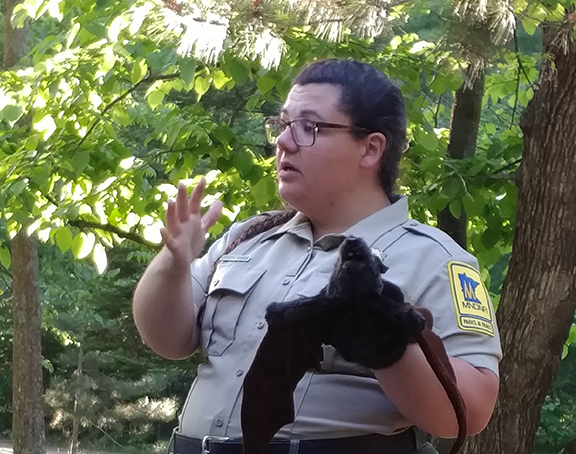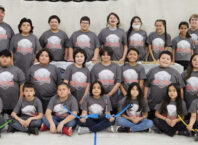By Amy Barrett
Larissa Harris (Onondaga) recently started work as Department of Natural Resources (DNR) Area Naturalist for Lake Bemidji State Park and the Big Bog State Recreation Area. Harris has an M.A. in anthropology from the University of Manitoba and a B.A. in anthropology/archaeology from Minnesota State University Moorhead. She has been a teacher and mine interpreter at Lake Vermillion-Soudan Underground State Park.
State park naturalists interact with park visitors through education and recreation programs, staff visitor centers, and help with resource management activities. In this question and answer format, she explains how her Onondaga heritage influences her life and work.
Why did you go into this line of work?
I went into naturalist interpretation because when I was in college, I became frustrated with what I was seeing from archaeologists and museums: excavations would happen, artifacts would get dug up, and then they would be stored in boxes on shelves where no one could see them. As a naturalist, I got to take those things out of boxes and share their stories with everyone.
When did you first become interested in the environment?
I think I have always been interested in the environment because it has always been part of my life: my family always lived in the “country,” we always had gardens, we always spent time camping and doing outdoor recreation activities. The older I got, the more my interactions with the environment shifted to conservation, especially as I saw more and more environmental degradation through oil spills and increased carbon emissions and climate change. In my lifetime (and I’m still pretty young), I have started to see major shifts in the environment around me, in the migration patterns of birds, and in extreme weather events; all of that is more than enough to take a vested interest in the environment.
How does your Onondaga heritage inform your work?
As an Onondaga woman, my heritage influences almost every aspect of my life: from the moment I wake up until I close my eyes at night, I make sure that I walk with purpose and a good heart, that I am respectful of not only my fellow human beings, but of the other beings around me and the earth beneath me, and that every action I take would make my ancestors proud. I almost always have tobacco with me when I go out into the woods, sometimes because I will be collecting things, sometimes because I will be learning things, but always because I am respectful of the great responsibility I have to care for Mother Earth, and to share that with others in a way that makes them feel responsible as well.
What is a typical day like?
I wouldn’t say I have a typical day quite yet; each day is different. Each changes depending on whether or not I have meetings or programming or program development to do. I have only been in my job now for a little over a month; probably after I have been here longer, I will start to have typical days.
How much of a typical day do you spend outside?
If I’m not stuck in meetings or travelling to Big Bog State Recreation Area, I can spend as much as 80 percent of my normal work day outside in the park.
What advice would you give to a young person who had an interest in the outdoors and protecting the environment?
For any of the youth who are interested in the outdoors and protecting the environment, my advice would be that you are never too young to start making a difference. Small actions at home or in your community like collecting and properly disposing of trash and recycling can have huge, positive impacts on the environment. Conservation is often a grassroots effort, and if the youth become engaged in it early, they will take it with them wherever they may go. Being outdoors doesn’t mean you have to live in the Northwoods. Even in a major city, you can find wild areas like parks where you can experience plants and wildlife. I think the biggest thing to keep in mind when the youth begin heading outdoors is that while the unknown can be kind of scary, education is a great way to overcome fear.
What’s the best part of your job? What’s the most challenging?
The best part about my job is that I get to spend every day sharing information with people that is not only important, but also really fun. I remember being a kid and attending naturalist programs, and I never would have guessed I could do that as an actual job! One of the most challenging things about my job is that I feel like I never have enough time in the day. There’s always one more thing that needs to be done for the next day.
Why did you study anthropology? Does that background contribute to what you do as a naturalist?
I went into anthropology, and specifically archaeology, because I did not like the history of cultural theft that had been happening to Indigenous people when anthropologists and archaeologists came into communities. I decided that the best way to change this issue was to become trained as an archaeologist so I could be a part of the process and make sure it was done appropriately. I think I’ve followed that same line of thinking as I’ve worked for the Department of Natural Resources in different positions.
What are your interests outside of work?
On my days off, I can be found spending time with my two dogs (Ziina and Gynger) and my boyfriend (James), usually travelling around the state visiting some of our favorite places and our families. I also have a horse named Bohannon that I enjoy spending time with. When things start to get cold, I read and work on my regalia. I am a jingle dress dancer.
What is your favorite part of meeting with the public?
I really enjoy meeting with the public because I like the ‘wow factor’ of being able to share new information with people that surprises them, especially with kids.







